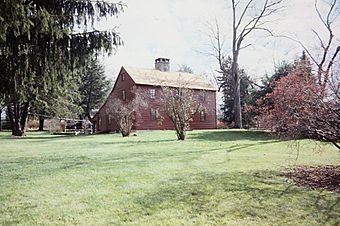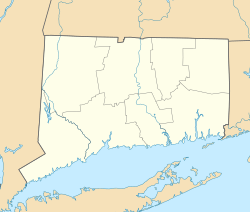Thomas Hawley House facts for kids
Quick facts for kids |
|
|
Thomas Hawley House
|
|

Thomas Hawley House
|
|
| Location | 514 Purdy Hill Rd., Monroe, Connecticut |
|---|---|
| Built | 1755 |
| Architectural style | Saltbox Colonial |
| NRHP reference No. | 80004059 |
| Added to NRHP | April 11, 1980 |
The Thomas Hawley House is a very old farm house in Monroe, Connecticut. It was built in 1755, long before the United States became a country! This house is special because it's a type called a saltbox house, known for its unique shape. It was built using a method called post-and-beam, which means it has a strong wooden frame. Thomas Hawley, who built the house, was related to one of the first settlers of Stratford, Connecticut. This house helps us remember what life was like in Colonial America.
Contents
Who Was Thomas Hawley?
The Thomas Hawley House is one of the few buildings left from when the area, now called Monroe, was first settled. It also reminds us that most people living there long ago were farmers. Monroe was once the northern part of Stratford, which was settled in 1639.
Thomas Hawley's Family and Early Life
In the early 1700s, families like the Hawleys moved into the wilderness to create farms. Thomas Hawley was the great-grandson of Joseph Hawley. Joseph was one of the first people to settle Stratford, Connecticut. He bought most of the land that is now Monroe from the Paugusset Indians in 1671. Thomas Hawley was born on September 8, 1734, in what is now Trumbull, Connecticut. He married Sarah Olcott in 1760 and they had ten children!
Why Was New Stratford Formed?
In 1761, Thomas Hawley and 47 other men from North Stratford (now Trumbull) asked the Connecticut General Court for permission to start their own church area, called a parish.
The Need for a New Church
Their closest church, or "meetinghouse" as they called it, was more than three miles (5 km) away. This made it hard for people in North Stratford to follow the law that said everyone had to go to church all day on Sundays. The court agreed to their request. In 1762, they created the New Stratford Ecclesiastical Society. This society later became the Town of Monroe in 1823.
What Does the House Look Like?
The Thomas Hawley House is a "saltbox" style home built before the American Revolution. It has two and a half stories and is about 37 by 40 feet (11 by 12 meters).
Key Features of the House
The house has a side gable roof, a main entrance in the middle, and a large stone chimney in the center. The roof is steeper on the main part of the house and less steep on the kitchen area. This suggests the kitchen was probably added later. The outside of the house is covered with wooden boards called clapboard, painted a dark red. The roof is made of natural wood shingles. The windows have smaller panes of glass, with nine panes over six on the first floor and six over six on the second floor. There are no original farm buildings left, like the barn or a small house for enslaved people, that were mentioned in old records.
Thomas Hawley and the Revolutionary War
Captain Thomas Hawley helped during the American Revolutionary War, even though he wasn't fighting on the battlefield.
Helping the War Effort at Home
He is thought to have been part of the Committee of Inspection in 1776. This group was like a neighborhood watch in Stratford, which included Monroe at the time. Their job was to "keep watch and ward" because the area was close to the vulnerable Long Island coast.
Later Years of the House
Records show that Thomas Hawley owned two enslaved people as late as 1800. Slavery existed in Connecticut on a small scale since the 1600s. However, it was not as widespread as in the Southern states.
The End of Slavery in Connecticut
By 1800, most Black residents in Connecticut were free. They were freed by their owners, bought their own freedom, or were set free by new laws. These laws were designed to slowly end slavery in Connecticut. By 1810, Thomas Hawley no longer owned enslaved people.
Passing Down the House
Thomas Hawley died in 1817 when he was 83 years old. He left behind almost 150 acres (0.61 km²) of land. Records from his death show the house was valued at $160.00, a small house for enslaved people at $10.00, and a barn at $130.00. His son, David Hawley, inherited the property. His family lived in the house for another 100 years. In the 1920s, F. William Behrens, who was the mayor of Bridgeport, bought the Thomas Hawley house to use as a summer home.




